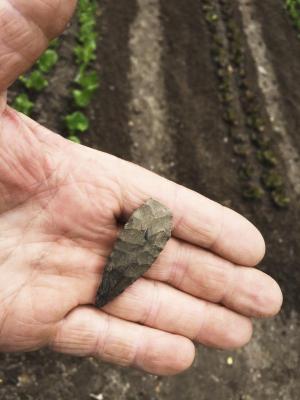We’ve had an uncharacteristically nice spring here along the coast. A little warmer and drier than usual. Rainfall-wise, we’re still running more than an inch behind normal for this time of year. Normal for the first three and a half months is about 13.75 inches. As of April 21, we stood at about 12.31 inches.
Easter Sunday was sweet with lots of sunshine and warmth. All good. I hesitate to say any more. Spring along the coast can turn quickly. The ocean temperature stands now at 56 degrees, and if the wind swings around to the east, things will get cooler. And then will come gray days and fog interspersed with sunshine. Cool days make the blooming plants hold on longer. Pretty.
Chuck Burton tends a fine garden each year at his place a few miles west of Lewes. When he’s ready to start planting, his garden plot is smoother than a carpet. It yields a nice variety of vegetables. But that’s not all Chuck’s garden yields.
He sent me a photograph the other day of an arrowhead he found as he was turning soil. A beauty. I’ve included the picture here. Over the past few decades, Chuck's found hundreds of points in all shapes and sizes. When soil gets turned in the spring and rains come, points will occasionally appear magically on top of clumps. In that respect, they're somehow akin to mushrooms.
Over time, the constant freezing and thawing of the earth and the turning of the soil begins to reveal the workings of Native Amerticans who lived in these parts for thousands of years prior to the arrival of Eurpoean explorers. Arrowheads provided hunters with a good source of protein via the abundant wildlife that roamed the woods here.
Long after lost arrows disintegrated, their points remained in the earth to be discovered by sharp-eyed gardeners and others who walk freshly turned fields in the spring to make contact with ancient history. Points nestle in the soil until they’re turned up. Then a rain washes away the soil and often leaves them perched atop clumps that display them as if on crude pedestals.
Anyone who has walked freshly plowed furrows and suddenly spied a beautiful arrowhead knows that special thrill.
Skunk cabbage and hostas
I saw lots of skunk cabbage fully unfolded along wet sections of the Junction & Breakwater Trail last weekend. They look like hostas, and anyone who knows hostas knows they’re a handsome and prized plant that thrives in shaded areas. Deer and other animals love to eat hostas, but not so much skunk cabbage. Tear a leaf of the skunk cabbage plant, take a sniff, and you’ll understand why it’s named as it is and why animals don’t find it appetizing.
Those who get anxious for signs of spring in early March will find skunk cabbage plants in wet areas of the woods. These perennials find their way up through dark, thick mud and often push their way up through ice and snow.
Skunk cabbages are older than arrowheads by hundreds of thousands of years. Think dinosaurs. They are able to push up through ice and snow because they can raise the air temperature around their bud tips by as much as 36 degrees Fahrenheit - up to 72. They generate heat by converting starch in their roots to sugar. That enables skunk cabbages to get out of the ground early and attract pollinators. The rotten-meat smell that gives skunk cabbage its disagreeable odor attracts insects that get the pollinating job done. It’s a unique form of sustainable perpetuation called thermogenesis.
Lewes growing quieter
Now let’s shift gears from smell to sound.
I’ve lived in Lewes for 44 years. When I first came to town the regular sounds were remarkable, especially in the warmer months when they came through open windows day and night. A whistle blew at 7 a.m. and 5 p.m. on weekdays, a remnant of the days of a grain mill that called workers in the morning and dismissed them in the evening.
The fire siren cycled once at noon and 1 p.m. Fishing boats at the canal docks blew their horns upon departing; horns on the lighthouses warned mariners when fog banks rolled in off the ocean and reduced visibility to nil; bells from several churches rang on Sunday mornings; and emergency fire truck, ambulance and firehouse sirens provided a steady sound track day and night.
Most of those regular sounds have faded away. Several months back, neighbors of the firehouse in Lewes questioned the necessity of blowing the siren so often for alarms. Fire department volunteers met with the neighbors, heard concerns and objections, and responded with changes to their protocol for blowing sirens based on the severity of the incidents needing help.
One night last week I awoke suddenly in the middle of the night. It wasn't a loud noise that broke my sleep. It was the palpable silence that woke me, and the subconscious realization that Lewes had become even quieter.
In all that quiet, I strain my ears occasionally - especially when an east wind blows - to see if I can hear surf rolling up on the beaches a mile or so away. No success yet.
Now what I hear coming through the window at night - instead of the sirens, noisier car engines and tires of the past - are the songs of spring peepers and the occasional high-pitched whine of a motorcyclist footing his way through the gears after leaving his patience behind at a stoplight out on Route 1.
I like the quiet, but occasionally I miss the company of those many sounds that have been part of a town’s culture in the past.























































